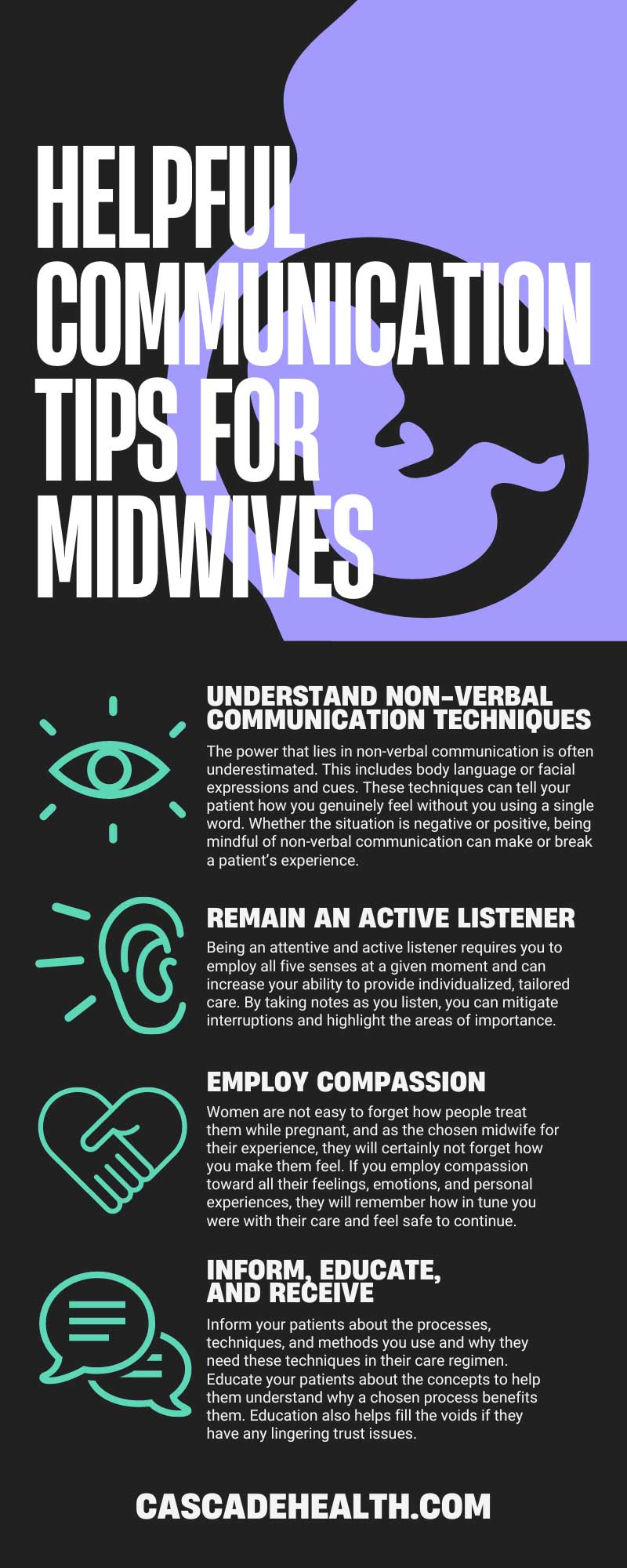6 Helpful Communication Tips for Midwives
Communication is the basis for human connection. Whether you use body language, eye contact, or words, how you communicate can relay information and distinct emotions and serve as the foundation for relationships and partnerships. As midwives, communication is the most crucial factor in maintaining reliable and safe patient partnerships. Let’s take a closer look at some helpful tips for effective communication practices.
The Importance of Midwifery Communication
Midwives play integral roles in the lives of women and mothers. The ability to effectively communicate with a patient will move mountains for them and their ability to navigate pregnancy and the beginnings of the motherhood experience. Generally, certified nurse midwives learn communication basics in school and clinical settings.
Various elements such as accuracy, empathy, general knowledge, and individualized care come from a place of learned and professional communication. These factors are of the utmost importance because care settings can change from clinics, hospitals, homes, and birthing centers. Remaining consistent across locations is beneficial not only to the mother and their partner but also to the care facilities.
The role of a midwife in a woman’s life extends beyond the title of medical practitioner overseeing her care. Often, a woman will hire a midwife to aid in her pregnancy and determine her birth preferences while also having the care of a trained doula, overseeing OBGYN, and a primary care physician. So, a midwife must maintain a certain level of communication that aligns with these important roles to ensure the mother receives the care she needs regardless of who she sees on any given day.
Below, we discuss six helpful tips for midwives to maintain authentic, authoritative communication for mothers, their partnering care team, and other involved partners.
Understand Non-Verbal Communication Techniques
The power that lies in non-verbal communication is often underestimated. This includes body language or facial expressions and cues. These techniques can tell your patient how you genuinely feel without you using a single word. Whether the situation is negative or positive, being mindful of non-verbal communication can make or break a patient’s experience.
An example of non-verbal communication would be if you are panicking, worried, or expressing fear through rapid movements and hyperactivity. This may tell the mother that things are intense and you are concerned about her condition. In contrast, remaining calm, moving with intention, and being slow to make another move may indicate to her that you are not worried, trusting of the process, and willing to allow her to make the next decision.
A few other notables in non-verbal communication often include general posture, eye movements or contact, smiling, and in which direction your body is facing in relation to the patient.
It’s essential to note that all bodily movements, good or bad, are human and valid. But remember to present yourself professionally and mind these non-verbal communication techniques, as your patients and their partners are watching for clues or insights.
Remain An Active Listener
Truthfully, a midwife cannot effectively or accurately administer care without being an active, attentive listener. Giving your patients ample opportunity to express their fears, concerns, and relevant issues can ensure you are evaluating the situation.
Being an attentive and active listener requires you to employ all five senses at a given moment and can increase your ability to provide individualized, tailored care. By taking notes as you listen, you can mitigate interruptions and highlight the areas of importance.
Employ Compassion
Employing compassion is an essential form of communication for a midwife, especially when a patient expresses their potential fears or concerns. Pregnancy and childbirth are no easy feats—especially for new moms and mothers experiencing something for the first time. These new experiences can cause them to express a series of emotions.
Women are not easy to forget how people treat them while pregnant, and as the chosen midwife for their experience, they will certainly not forget how you make them feel. If you employ compassion toward all their feelings, emotions, and personal experiences, they will remember how in tune you were with their care and feel safe to continue.
Inform, Educate, and Receive
Inform, educate, and receive is a method of communication that helps you offer your patients the ability to learn through the process, ask questions, and remain their best advocate.
Inform your patients about the processes, techniques, and methods you use and why they need these techniques in their care regimen. Educate your patients about the concepts to help them understand why a chosen process benefits them. Education also helps fill the voids if they have any lingering trust issues.
Using education as a line of defense can lend a hand in the patient’s ability to trust you and the process. Lastly, being open to receiving questions during the informing and educating process is the patient’s best way to digest the information and refine their care needs.
Comprehensive Written Communication
One of the first skills a certified nurse midwife will master while in school and clinical settings is comprehensive written communication. This set of skills will be one of the primary forms of communication used in a midwife’s daily routines. Taking effective notes after house calls or patient appointments, communicating with the patient and other care providers, and charting must all remain concise, digestible, professional, and legible.
The cross-appointed care a mother receives will require written communication that is easy for all providers to understand. The information must not be misconstrued, inaccurate, or lacking in detail. Additionally, the patient in care must understand the written communication in full detail without feeling confused or concerned regarding their care needs.
General Verbal Communication Techniques
Along with written communication, verbal communication is incredibly important and valuable to the care of a mother and her supporting partners. The consequences of a lack of verbal communication are often dire to a mother, her baby, and other care members. For example, when using waterproof doppler devices to listen to the baby’s heartbeat, verbal miscommunication may result in unnecessary panic.
Using the correct tone and sticking to the inform, educate, and receive model can help the mother understand the measurements and feedback, alleviate panic, and provide more accuracy during the scan. When the fetus senses anxiety from the mother, the heartbeat can become rapid. A midwife can avoid these issues by using a professional, compassionate verbal communication technique to ensure the mother understands and can accurately comprehend the situation.
Cascade Health Care is committed to ensuring midwives obtain the knowledge and equipment to perform their duties effectively and provide quality care. We feature a comprehensive line of dopplers to accompany basic care practices and provide thorough communication measures to mothers. Shop our selection today!

Recent Posts
-
Exploring Recent Innovations in Doppler Signal Processing
Doppler technology has become an essential diagnostic tool in modern medicine, enabling healthcare p
-
Exploring Recent Innovations in Doppler Signal Processing
Doppler technology has become an essential diagnostic tool in modern medicine, enabling healthcare p


